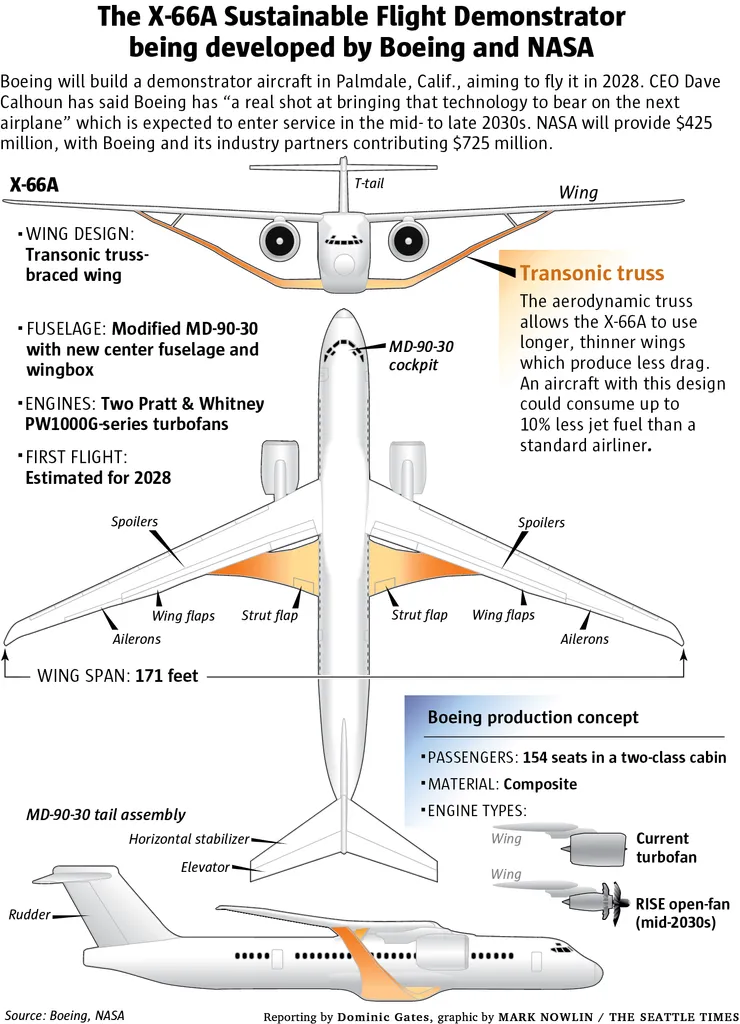The X-66A
- Boeing and NASA announced on Monday that the U.S. Air Force has designated the aircraft built under the agency’s Sustainable Flight Demonstrator project as the X-66A.
- As the mainstay of passenger airlines worldwide, the new X-plane aims to educate a prospective new generation of more environmentally friendly single-aisle aircraft. Boeing and NASA will collaborate to develop, test, and fly a full-scale demonstration aircraft with the Transonic Truss-Braced Wing design, which features extra-long, thin wings stabilized by diagonal struts.
- Our gaze is not just fixed on the stars at NASA, but also on the sky. “NASA Administrator Bill Nelson said the Sustainable Flight Demonstrator builds on NASA’s world-leading efforts in aeronautics and climate. “A new era of greener, cleaner, and quieter aircraft will be shaped by the X-66A, opening up new opportunities for both the American aviation industry and the flying public.”
- As stated in the White House’s U.S. Aviation Climate Action Plan, the X-66A is the first X-plane designed particularly to assist the United States in achieving the objective of net-zero aviation greenhouse gas emissions.
- Bob Pearce, associate administrator for NASA’s Aeronautics Research Mission Directorate, announced the designation at the American Institute of Aeronautics and Astronautics Aviation Forum in San Diego. “We need transformative aircraft concepts like the ones we’re flying on the X-66A to reach our goal of net zero aviation emissions by 2050.” “With this experimental aircraft, we’re aiming high to demonstrate the kinds of energy-saving, emissions-reducing technologies the aviation industry needs.” The Air Force grants X-plane designation to Boeing and NASA shortly after the agency announced the Sustainable Flight Demonstrator project award earlier this year.
- The X-66A was designated by the Air Force as an aircraft that validates technologies for a Transonic Truss-Braced Wing configuration that, when paired with other improvements in materials, systems architecture, and propulsion systems, could lead to up to 30% lower emissions and fuel consumption compared to today’s best-in-class aircraft.
- Single-aisle aircraft are currently responsible for almost half of global aviation emissions due to their extensive use. Emissions could be significantly reduced by developing designs and technologies for a more environmentally friendly version of this aircraft.
- When NASA’s predecessor organization, the National Advisory Committee for Aeronautics (NACA), collaborated with the Air Force and the U.S. Navy to establish an experimental aircraft program in the 1940s, the agency began using the X-plane name. The newest in a long line of NASA X-planes is the X-66A. For a number of other X-planes, NASA’s Armstrong Flight Research Center in Edwards, California, has also contributed technical know-how and assistance.
- Through a Funded Space Act Agreement, NASA will invest $425 million over seven years toward the Sustainable Flight Demonstrator, with the remaining financing, estimated at approximately $725 million, coming from Boeing and its partners. NASA will also provide facilities and technical know-how.
- A major component of NASA’s Sustainable Flight National Partnership, which focuses on creating new sustainable aviation technologies, the Sustainable Flight Demonstrator project is an endeavor within the agency’s Integrated Aviation Systems Program.
Share this content:














1 comment